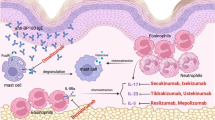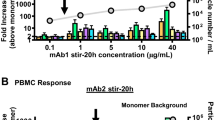Abstract
Leukotriene B4 (LTB4) and 12(R)-hydroxyeicosatetraenoic acid [12(R)-HETE] are proinflammatory products of arachidonic acid metabolism that have been implicated as mediators in a number of inflammatory diseases. When injected intradermally into the guinea pig, LTB4 and 12(R)-HETE elicit a dose-dependent migration (chemotaxis) of neutrophils (PMNs) into the injection sites as assessed by the presence of a neutrophil marker enzyme myeloperoxidase. SC-41930 {7-[3-(4-acetyl-3-methoxy-2-propylphenoxy)propoxyl]-3,4-dihydro-8-propyl-2H-1-benzopyran-2-carboxylic acid}, a first-generation LTB4 receptor antagonist, inhibited the chemotactic actions of LTB4 when given orally with an ED50 value of 1.7 mg/kg. The second-generation LTB4 receptor antagonist, SC-53228 [(+)-(S)-7-(3-{2-(cyclopropylmethyl)-3-methoxy-4-[(methylamino)carbonyl]phenoxy} propoxy)-3,4-dihydro-8-propyl-2H-1-benzopyran-2-propanoic acid], inhibited LTB4-induced chemotaxis when given intragastrically with an ED50 value of 0.07 mg/kg. Furthermore, SC-53228 inhibited 12(R)-HETE-induced granulocyte chemotaxis with an oral ED50 value of 5.8 mg/kg. When dosed orally over a range of 0.03–100 mg/kg, SC-53228 gaveC max plasma concentrations of 0.015–41.1μg/ml. SC-53228 inhibited LTB4-primed membrane depolarization of human neutrophils with an IC50 value of 34 nM. As a potent LTB4 receptor antagonist, SC-53228 may well have application in the medical management of disease states such as asthma, rheumatoid arthritis, inflammatory bowel disease, contact dermatitis, and psoriasis, in which LTB4 and/or 12(R)-HETE are implicated as inflammatory mediators.
Similar content being viewed by others
References
Palmblad, J., C. Malmsten, A. Uden, O. Radmark, L. Engstrot, andB. Samuelsson. 1981. Leukotriene B4 is a potent and stereospecific stimulator of neutrophil chemotaxis and adherence.Blood 58:658–661.
Redl, H., P. Flynn, H. Lamche, A. Schiesser, G. Schlag, andD. Hammerschmidt. 1983. Aggregation, chemotaxis and chemiluminescence of canine granulocytes.Inflammation 7:67–79.
Ford-Hutchinson, A., M. Bray, M. Doug, M. Shipley, andM. Smith. 1980. Leukotriene B4, a potent chemokinetic and aggregating substance released from polymorphonuclear leukocytes.Nature 286:264–265.
Hoover, R., M. Karnovsky, K. Austin, E. Corey, andR. Lewis. 1984. Leukotriene B4 action on endothelium mediates augmented neutrophil/endothelial adhesion.Proc. Natl. Acad. Sci. U.S.A 81:2191.
Czarnetzki, B., andR. Mertensmeir. 1985. In vitro and in vivo chemotaxis of guinea pig leukocytes toward leukotriene B4 and itsω-oxidation products.Prostaglandins 30:5–11.
Colditz, I., andH. Movat. 1984. Kinetics of neutrophil accumulation in acute inflammatory lesions induced by chemotaxis and chemotaxiningens.J. Immunol. 133:2169–2173.
Bhattacherjee, P., B. Hammond, J. Salmon, R. Stepney, andK. Eakins. 1981. Chemotactic response to some arachidonic acid lipoxygenase products in the rabbit eye.Eur. J. Pharmacol. 73:21–28.
Camp, R., A. Coutts, M. Greaves, A. Kay, andM. Walport. 1983. Responses of human skin to intradermal injection of leukotrienes C4, D4, and B4.Br. J. Pharmacol. 8:497–502.
Soter, N., R. Lewis, E. Corey, andK. W. Austin. 1983. Local effects of synthetic leukotrienes (LTC4, LTD4, and LTB4) in human skin.J. Invest. Dermatol. 80:115–119.
DeJong, E. M. G. J., P. E. G. van Erp, I. M. J. J. van Vlijmen, andP. C. M. van der Kerkhof. 1991. Cutaneous inflammation and proliferation induced by leukotriene B4.In Immunological and Pharmacological Aspects of Atopic and Contact Eczema. J. Czernielewski, editor. Karger, Basel, 72–75.
Kragballe, K., L. Desjarlais, andJ. J. Voorhees. 1985. Leukotriene B4, C4 and D4 stimulate DNA synthesis in cultured human epidermal keratinocytes.Br. J. Dermatol. 113:43–52.
Palmblad, J., R. Lerner, andS. H. Larsson. 1994. Signal transduction mechanism for LTB4-induced hyperadhesiveness of endothelial cells for neutrophils.J. Immunol. 152:262–269.
Yamaoka, K. A., andJ.-P. Kolb. 1993. Leukotriene B4 induces interleukin 5 generation from human T-lymphocytes.Eur. J. Immunol. 23:2392–2398.
Cunningham, F. M., andP. M. Woolard. 1987. 12(R)-hydroxy-5,8,10,14-eicosatetraenoic acid is a chemoattractant for human polymorphonuclear leukocytes in vitro.Prostaglandins 34:71–78.
Fogh, K., J. Kiil, T. Herlin, T. H. Ternowitz, andK. Kragballe. 1987. Heterogeneous distribution of lipoxygenase products in psoriatic skin lesions.Arch. Dermatol. Res. 279:504–511.
Woolard, P. M. 1986. Stereochemical difference between 12-hydroxy-5,8,10,14-eicosatetraenoic acid in platelets and psoriatic lesions.Biochem. Biophys. Res. Commun. 136:169–176.
Woolard, P. M., G. M. Murphy, F. M. Cunningham, R. D. R. Camp, andM. W. Greaves. 1988. Proinflammatory effects of 12(R)-hydroxy-5,8,10,14-eicosatetraenoic acid in human skin.Br. J. Dermatol. 118:277.
Evans, J. F., Y. Leblanc, B. J. Fitzsimmons, S. Charleson, D. Nathaniel, andC. Leveille. 1987. Activation of leukocyte movement and displacement of [3H]leukotriene-B4from leukocyte membrane preparations by 12(R)- and 12(S)-hydroxyeicosatetraenoic acid.Biochim. Biophys. Acta 917:406–410.
Cunningham, F. M., P. M. Woolard, andR. D. R. Camp. 1985. Proinflammatoty properties of unsaturated fatty acids and their monohydroxy metabolites.Prostaglandins 30:497–509.
Keith, R., W. Smith, B. Tsai, S. Levin, andG. Butchko. 1985. Myeloperoxidase activity in experimentally induced colitis.Fed. Proc. 44:1545.
Krawisz, J., P. Sharon, andW. Stenson. 1984. Quantitative assay for acute intestinal inflammation based on myeloperoxidase activity.Gastroenterology 87:1344–1350.
Bradley, P., D. Priebat, R. Christensen, andG. Rothstein. 1982. Measurement of cutaneous inflammation: Estimation of neutrophil content with an enzyme marker.J. Invest. Dermatol. 78:206–209.
Fretland, D., S. Levin, B. Tsai, S. Djuric, D. Widomski, J. Zemaitis, R. Shone, andR. Bauer. 1989. The effect of a leukotriene-B4 receptor antagonist, SC-41930, on acetic acidinduced colonic inflammation.Agents Actions 27:225–227.
Fretland, D., D. Widomski, J. Zemaitis, R. Walsh, S. Levin, S. Djuric, R. Shone, B. C. Tsai, andT. Gaginella 1990. Inflammation of guinea pig dermis: effects of leukotriene B4 receptor antagonist SC-41930.Inflammation 14:727–739.
Fretland, D., D. Widomski, B. Tsai, J. Zemaitis, S. Levin, S. Djuric, R. Shone, andT. Gaginella. 1990. Effect of the leukotriene B4 receptor antagonist SC-41930 on colonic inflammation in rat, guinea pig and rabbit.J. Pharmacol. Exp. Ther. 255:572–576.
Djuric, S. W., S. H. Docter, S. S. Yu, B. S. Tsai, C. P. Anglin, T. S. Gaginella, J. F. Kachur, R. H. Keith, T. J. Maziasz, D. Price, T. Rao, R. E. Walsh, D. L. Widomski, andD. J. Fretland. 1994. Synthesis and pharmacological activity of SC-53228, a leukotriene B4 receptor antagonist with high intrinsic potency and selectivity.Biorg. Med. Chem. Lett. 4:811–816.
Fretland, D. J., D. L. Widomski, C. P. Anglin, T. D. Penning, S. Yu, andS. W. Djuric. 1993. Leukotriene B4-induced granulocyte trafficking in guinea pig dermis: Effect of the second-generation LTB4 receptor antagonists, SC-50605 and SC-51146.Inflammation 17:353–360.
Tsai, B., R. Keith, D. Price, J. Kachur, D. Yang, S. Djuric, andS. Yu. 1994. The in vitro pharmacology of SC-51146: A potent antagonist of LTB4 receptors.J. Pharamcol. Exp. Ther. 268:1499–1505.
Fretland, D., D. Widomski, J. Zemaitis, S. Djuric, andR. Shone. 1989. Effect of a leukotriene B4 receptor antagonist on leukotriene B4-induced neutrophil chemotaxis in cavine dermis.Inflammation 13:601–605.
Fretland, D. J., D. L. Widomski, J. M. Zemaitis, B. S. Tsai, S. W. Djuric, T. D. Penning, J. M. Miyashiro, andR. F. Bauer. 1989. 12(R)-Hydroxyeicosatetraenoic acid is a neutrophil chemoattractant in the cavine, lapine, murine and canine dermis.Prostaglandins Leukotrienes Essent. Fatty Acids 37:79–81.
Smith, W., B. Cohen, S. Levin, andG. Butchko. 1986. In vivo chemotaxis to leukotriene B4 detected by myeloperoxidase activity.Fed. Proc. 45:63.
Borgeat, P., andP. H. Naccache. 1990. Biosynthesis and biological activity of leukotriene B4.Clin. Biochem. 23:459–468.
Fretland, D., D. Widomski, C. Anglin, S. Yu, andS. W. Djuric. 1992. Optical isomers of a leukotriene B4 antagonist have differential effects on granulocyte diapedesis in the guinea pig dermis.Chirality 4:1–3.
Fretland, D. J., D. L. Widomski, R. L. Shone, T. D. Penning, J. M. Miyashiro, andS. W. Djuric. 1989. SC-41930 inhibits neutrophil infiltration of the cavine dermis induced by 12(R)-hydroxyeicosatetraenoic acid.Prostaglandins Leukotrienes Essent. Fatty Acids 38:169–172.
Di Martino, M., C. E. Wolff, G. Campbell, andN. Hanna. 1989. The pharmacology of arachidonic acid-induced rat PMN leukocyte infiltration.Agents Actions 27:325–327.
Boughton-Smith, N. K., J. L. Wallace, andB. J. R. Whittle. 1988. Relationships between arachidonic acid metabolism, myeloperoxidase activity and leukocyte infiltration in a rat model of inflammatory bowel disease.Agents Actions 25:115–123.
Sharon, P., andW. F. Stenson. 1984. Enhanced synthesis of leukotriene B4 by colonic mucosa in inflammatory bowel disease.Gastroenterology 86:453–460.
Stenson, W. F. 1988. Arachidonic acid metabolites in inflammatory bowel disease.Adv. Inflam. Res 12:215–222.
Stenson, W. F. 1988. Leukotriene B4 in inflammatory bowel disease.In Inflammatory Bowel Diseases. H. Goebell, editor. MTP press, Lancaster, U.K. 143–152.
Ziboh, V., T. Casebolt, C. Marcelo, andJ. Voorhees. 1984. Biosynthesis of lipoxygenase products by enzyme preparations from normal and psoriatic skin.J. Invest. Dermatol. 83:426–430.
Brain, S., R. Camp, P. Dowd, A. Kobza-Black, andM. Greaves. 1984. The release of leukotriene-B4-like material in biologically active amounts from the lesional skin of patients with psoriasis.J. Invest. Dermatol. 83:70–73.
Fretland, D. J., andS. W. Djuric. 1989. 12(R)- and 12(S)-Hydroxyeicosatetraenoic acids: chemistry, biology, and pharmacology.Prostaglandins Leukotrienes Essent. Fatty Acids 38:215–228.
Kragballe, K., L. Desjarlais, E. A. Duell, andJ. J. Voorhees. 1986. In vitro synthesis of 12-hydroxyeicosatetraenoic acid is increased in uninvolved psoriatic epidermis.J. Invest. Dermatol. 87:47–52.
Grob, E., T. Ruzicka, C. Mauch, andT. Krieg. 1988. Evidence for LTB4/12-HETE binding sites in a human epidermal cell line.Prostaglandins 36:49–58.
Barr, R., S. Brain, R. D. R. Camp, F. F. Derm, J. Cilliers, M. W. Greaves, A. Mauet, andK. Misch. 1984. Levels of arachidonic acid metabolites in the skin in human allergic and irritant contact dermatitis.Br. J. Dermatol. 111:23–28.
Ruzicka, T., T. Simmet, andB. A. Peskar. 1986. Skin levels of arachidonic acid-derived inflammation mediators and histamine in atopic dermatitis and psoriasis.J. Invest. Dermatol. 86:105–108.
Williams, T. J., A. Das, C. von Vexkull, andS. Nourshargh. 1991. Neutrophils in asthma.Ann. NY Acad. Sci. 629:73–81.
O'Byrne, P. M. 1990. Eicosanoids and inflammatory cells in asthma.Agents Actions Suppl. 31:85–101.
Calhoun, W., J. Sedgwick, andW. Busse. 1991. The role of eosinophils in the pathophysiology of asthma.Ann. NY Acad. Sci. 629:62–72.
Lucchesi, B., andK. Mullane. 1986. Leukocytes and ischemia-induced myocardial injury.Annu. Rev. Toxicol. 26:201–224.
Mullane K. 1988. Eicosanoids in myocardial ischemia/reperfusion injury.Adv. Inflammation Res. 12:191–214.
Zimmerman, B., D. Guillory, M. Grisham, T. Gaginella, J. Mallarkey, andD. N. Granger. 1990. Role of leukotriene B4 in granulocyte infiltration into the postischemic feline intestine.Gastroenterology 99:1358–1363.
Ahmadzadeh, N., M. Shingu, U. Sosumi, M. Nobunaga, andT. Tawara. 1991. Relationship between leukotriene B4 and immunological parameters in rheumatoid synovial fluids.Inflammation 15:497–503.
Spurney, R. F., S. Ibrahim, D. Butterfly, P. E. Klotman, F. Sanfilippo, andT. M. Coffman. 1994. Leukotrienes in renal transplant rejection in rats.J. Immunol. 152:867–876.
Konstan, M. W., R. W. Walenga, K. A. Hilliard, andJ. B. Hilliard. 1993. Leukotriene-B4 markedly elevated in the epithelial lining fluid of patients with cystic fibrosis.Am. Rev. Respir. Dis. 148:896–901.
Djuric, S. W., D. J. Fretland, andT. D. Penning. 1992. The leukotriene B4 receptor antagonists—a most discriminating class of antiinflammatory agents?.Drugs Future 17:819–830.
Ziboh, V. A. 1994. Essential fatty acids and eicosanoid biosynthesis in the skin: Biological significance.Proc. Soc. Exp. Biol. Med. 205:1–11.
Author information
Authors and Affiliations
Rights and permissions
About this article
Cite this article
Fretland, D.J., Anglin, C.P., Bremer, M. et al. Antiinflammatory effects of second-generation leukotriene B4 receptor antagonist, SC-53228: Impact upon Leukotriene B4- and 12(R)-HETE- mediated events. Inflammation 19, 193–205 (1995). https://doi.org/10.1007/BF01534461
Issue Date:
DOI: https://doi.org/10.1007/BF01534461




